Why Do Strange Dogs Get "All Up In Your Business?"
Frank Rosell, Secrets of the Snout
 Scientist and Researcher Frank Rosell joins us live from Norway to talk about our pet's incredible nose and smelling capabilities. He'll explain why your friend's dog is "all-up-in-your-business" and just how far and how much our dog can smell stuff. They can even smell cancer.
Scientist and Researcher Frank Rosell joins us live from Norway to talk about our pet's incredible nose and smelling capabilities. He'll explain why your friend's dog is "all-up-in-your-business" and just how far and how much our dog can smell stuff. They can even smell cancer.
Pets are very unique in that they give you unconditional love. Plus, they can see things we can't; they can hear things we can't; and they can smell things we can't, making them great protectors. Dr. Frank Rosell is a Professor at the Department of Environmental and Health Sciences at the University College of South East Norway. He studies noses, not just dog noses, but also the noses of all types of animals.
As a young kid, Dr. Rosell became interested in the smells that only animals can smell. He received his first dog, a Shetland Sheepdog named Tinka, when he was twelve years old. Tinka would follow him on all his beaver trips, because he actually ran a long-term project about beavers in Norway. That's when he started to observe Tinka. She used her nose everywhere and she was even able to smell beaver scent marks.
Originally, Dr. Rosell studied the olfactory senses of beavers, which was his focus for the last 30 years. He tells us that the nose of a beaver is almost as good at smelling things like the nose of a dog.
But when it comes to dogs, why is it when you're out walking your dog they seem to stop about every 10 feet to smell the ground? This is because they can get a lot of information from smells left behind from other dogs. First of all, when they smell the urine of other dogs, they understand that is was another dog that left the urine. No one really knows, but they may also be able to tell what type breed left the urine. However, they can definitely tell if it was a male or female dog. If it's a female, they can also tell if she's in heat or not. They can also tell if they have met the dog before. And lastly, they can tell the age of the urine and have an idea of how long ago the dog was there.
Some studies show that dogs use their right nostril for things that are unfamiliar and they use their left nostril for familiar sense. If the scent is not dangerous, like a secretion from a female dog, they actually first use the right nostril because they are not sure what it is. They then switch to left, because they are more certain that it is nothing dangerous. So they are using the left side of the brain. The left side of the brain is connected to the left nostril. For instance, if your dog smells the scent of a veterinarian, they use only the right nostril. This means that the right side of the brain is connected to negative emotions.
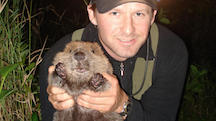 Another interesting thing you should be aware of is the tail wagging of a dog. If the tail is going to the right side of the dog, his right side, then they are actually happy. So it's opposite compared with their nostrils. So here it's changed and it's going from the right side of the body to the left side of the brain. The nerve crosses here. It's the opposite and you need to be aware of this. If you see another dog in a dog park for instance and their tail is wagging to the left, then you should be worried, that is a negative emotion.
Another interesting thing you should be aware of is the tail wagging of a dog. If the tail is going to the right side of the dog, his right side, then they are actually happy. So it's opposite compared with their nostrils. So here it's changed and it's going from the right side of the body to the left side of the brain. The nerve crosses here. It's the opposite and you need to be aware of this. If you see another dog in a dog park for instance and their tail is wagging to the left, then you should be worried, that is a negative emotion.
So why does a dog go right for your crotch when you first meet them? Dr. Rosell explains that if you think about it, you have 5 million different scent glands on your body. You also have apocrine scent glands that are in your private areas. The scents from these glands say something about who you are. So the dog first tries to identify you. Later they may then actually sniff other parts of your body to figure out what kind of emotional or mental state you are in. It has nothing to do with cleanliness.
No one really knows just how far away dogs can smell things. However, Dr. Rosell has heard rumors that a male dog can sniff a female in heat two and a half miles away. Dr. Rosell explains that his dog disappeared one morning. He later found him a little over a mile away on a porch where a female in heat lived, as happy as ever wagging his tail to the right!
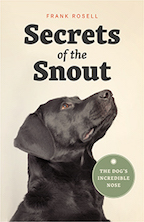 Dogs are even able to detect when someone is going to have a seizure; when someone has diabetes; or even when someone has cancer. How are the dogs able to identify these things? Dr. Rosell states that it's not that easy with a seizure. More research is being done, but it probably has to do with changing cells. When a person breathes out, a dog can sniff the change. When it comes to cancer, a dog sniffed the leg of a woman in England. The dog figured this out because the mole was releasing some chemicals that were not there before.
Dogs are even able to detect when someone is going to have a seizure; when someone has diabetes; or even when someone has cancer. How are the dogs able to identify these things? Dr. Rosell states that it's not that easy with a seizure. More research is being done, but it probably has to do with changing cells. When a person breathes out, a dog can sniff the change. When it comes to cancer, a dog sniffed the leg of a woman in England. The dog figured this out because the mole was releasing some chemicals that were not there before.
Dogs are even able to sniff out pirated CDs and DVDs at custom borders. Dogs found a lot of CDs in Asia that were illegally produced. They can sniff out more or less everything you can imagine. They just need a scent and they can sniff it out.
Dogs also like stinky things. So why does your dog roll in dead things? Dr. Rosell believes that this is because they are trying to remove their own scents. While we really don't know, it is suspected that many years ago it was believed that wolves did this so other predators wouldn't eat them.
Dr. Rosell was really surprised when he wrote his book, Secrets of the Snout, that dogs had so many different jobs that we've given to them. They can sniff out everything from diseases, to bombs to pirated CDs. From his own research, Dr. Rosell has even used them for sniffing out beaver scents. He explains that in in Finland they have introduced two beaver species. There is the invasive North America Beaver and the native Eurasian Beaver. Because he has a background as a chemical engineer, Dr. Rosell did some chemical analysis. He used something called the GC-MS, or gas chromatography and mass spectrometers, and he couldn't find a difference between these two species of beavers. So he asked the dogs and they were actually able to sniff it out. The dogs told him which one was the North American and which one was the Eurasian Beaver. In Finland, the whole purpose of this study is that they don't find the North American beaver in Finland. So then just giving him a cent mark, he can then just ask his dogs to tell him which species it is.
It's no surprise that Dr. Rosell has about 1,500 different "poos" from beavers, as well as from other animals, stored in his freezer and he's sure all of his colleagues are not happy about it!
Visit Website
What To Do When You Can't Reach A Veterinarian
Dr. Dawn Crandell, Fear Free
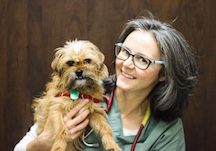 It seems like you always need your veterinarian when they are on vacation or you are on vacation! Dr. Dawn Crandell is a Diplomat of the American College of Veterinary Emergency and Critical Care and tells us what to do when you can't reach a veterinarian.
It seems like you always need your veterinarian when they are on vacation or you are on vacation! Dr. Dawn Crandell is a Diplomat of the American College of Veterinary Emergency and Critical Care and tells us what to do when you can't reach a veterinarian.
While in this day and age there is more connectivity, if you happen to be on a really remote camping trip, you might have a hard time reaching your veterinarian. Or, if you're in an area where your cell phone coverage is poor or absent, you might have a hard time reaching out to a veterinarian and be totally on your own. Fortunately, most of the time there is often a way to make a phone call to get some advice, which is helpful.
Dr. Crandell explains that veterinarians are obligated to provide you with 24-hour care. Obviously they can't always do that themselves, but they should at least forward you to another service that can offer you some care. Many veterinarians also refer their clients to overnight care clinics or 24-hour practices when they themselves aren't available to help you.
It is certainly wise to scout out the area that you're going to be traveling to ahead of time and find out what veterinary clinics are in the area, what their hours are and what emergency clinics might be servicing them in the off hours. You should have that contact information available so you're not trying to look it up if you're in a frantic hurry.
When traveling with your pet, Dr. Crandell advises that it's always a good idea to carry a pet first aid kit. A pet first aid kit is similar to a human first aid kit. However, the bandage material might be a little bit different in that it's hard to just often slap a bandage on a small cut on a dog. They usually need a little bit more bandage material than you would use on a human. As a result, you would probably want to prepare yourself with an abundant amount of gauze, squares and absorbent wrap along with some of that self-cling tape and adhesive tape.
Other things that are often useful in a first aid kit are medications. It's totally worth a chat with your veterinarian before you head off to know what medications would be useful for your particular trip and for your particular pet. Be aware that if there are any other things going on with your pet, this could affect what you would give them.
Some medications to think about would be over the counter anti-histamines, maybe even a starting dose of an antibiotic. You should even take generic antidiarrheal medications along. You might also want to take a topical eye antibiotic and a topical antibiotic ointment, as these kinds of things are actually pretty useful on a trip just to get started until you can get into see a veterinarian.
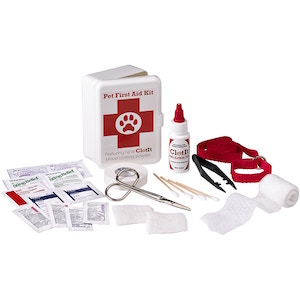 Another item for your pet first aid kit that you might want to think about would be tick pullers or fine tweezers. They make little plastic gadget to take ticks off pretty easily and those are pretty helpful. A pair of plastic gloves or latex gloves so you don't have to touch anything is also useful. If you're in porcupine country, you should have small needle nose pliers to take out any quills if your dog has just a few and they have a calm temperament. If your dog has a lot of quills, you should probably get a veterinarian to help you.
Another item for your pet first aid kit that you might want to think about would be tick pullers or fine tweezers. They make little plastic gadget to take ticks off pretty easily and those are pretty helpful. A pair of plastic gloves or latex gloves so you don't have to touch anything is also useful. If you're in porcupine country, you should have small needle nose pliers to take out any quills if your dog has just a few and they have a calm temperament. If your dog has a lot of quills, you should probably get a veterinarian to help you.
A bottle of eye rinse is also very helpful if your dog encounters a skunk, because that's a pretty nasty chemical they can get in their eyes.
And lastly, you might want to consider putting a muzzle in a pet's first aid kit. This is because dogs that are badly hurt will sometimes redirect a bite to whoever touches them. That's pretty normal behavior and not at all a comment on the friendliness of your dog. People should be aware of that and have a way to protect themselves if they need to.
So how do you know if it's just an urgent situation or if it's a true emergency? Dr. Crandell admits that that's always a hard call if you're trying to decide if you need to kill your camping trip and get out of there to see the veterinarian. If it's a true emergency, there are some obvious things.
If there's clearly a limb fracture, that's a true emergency and you need to get your pet to the veterinarian right away. If your pet is not willing or able to get up and move around, that's usually a sign that things are pretty bad and it's an emergency.
Dr. Crandell tells us that she has occasionally seen pets that are running through the forest super fast and they will actually impale themselves on a stick. That's a true emergency.
Also, bigger dogs tend to get a problem called gastric dilation volvulus, which can come up very fast and needs to be seen as soon as possible. Those dogs would have a nonproductive retching and vomiting, which means there is clearly something bad happening and they are clearly sick dogs. The have no energy and they really just don't want to be with you because they're so distressed. Their belly might be distended. This is definitely an emergency.
If there were significant bleeding or hemorrhaging, that would be something you'd, classify as a true emergency.
One thing owners should do ahead of time is to be proficient in assessing their pets when they are well so they have a sense of what is normal for their pet, says Dr. Crandell.
You should know what the gum color of your pet looks like when they are healthy so you know what is normal for your pet. When they're really sick, their gum color looks quite pale or gray and that's usually a pretty bad sign, which tells you a veterinarian should see them right away.
You should also have an idea of your pet's normal resting heart rate. If it's significantly faster than usual, that's usually a sign that things are not going well.
 Also look at how they're breathing. If they have an increased rate of breathing or a clear increased effort, that's an emergency.
Also look at how they're breathing. If they have an increased rate of breathing or a clear increased effort, that's an emergency.
Another thing that you can check is the temperature of their paws. If it's not cold where they are, but their limbs are cold, that's usually a sign their circulation is quite poor and that truly is an emergency as well.
If you see any of these emergency signs with your pet, cut your trip short and get in to see a veterinarian right away.
The line between urgency and emergency is so delicate and thin; you might not even be able to see it. It's hard to make those calls sometimes if you're not a veterinarian, explains Dr. Crandell, so if you're at all concerned, it's worthwhile to stop the trip and get your pet to a veterinarian.
Visit Fear Free Happy Homes for tips on making your home fear free and to locate a Fear Free Veterinarian near you. Go to Fear Free Pets to become certified.
Listen and Explore the Fear Free Expert Series
Woman Has Same Pet For Over 55 Years
Jeanna Smith & George
 Here's a story you don't hear very often. Jeanna Smith got her pet tortoise during the Kennedy administration, and it might still be alive for the Bieber administration. Not many people live most of their life with their childhood pet.
Here's a story you don't hear very often. Jeanna Smith got her pet tortoise during the Kennedy administration, and it might still be alive for the Bieber administration. Not many people live most of their life with their childhood pet.
Ever since she was a little girl, Jeanna has loved turtles and tortoises and really wanted one that she could keep. Fortunately, her father was a friend of the local zoo director in Milwaukee at that time and arranged for her to get a gopher tortoise. She named him George and that was her 10th birthday present.
Jeanna felt very connected to George right from the beginning and was very serious about his care. She also took George with her everywhere she went. When she was a little girl, George would ride in her bike basket and go to her best friend's house. When her family went on summer vacations to a cabin in Wisconsin, George would come along. George even walked the beach of the shores of Lake Michigan.
Because she took George wither everywhere, it was no surprise when Jeanna went to college and George went with her. She doesn't believe that the officials were really aware what was going on, but of course all her friends on the floor of her dormitory knew George was there. However, he was a very quiet and didn't bother anyone.
During her college years, Jeanna met Kirby Smith, who eventually became her husband. Kirby learned right away that Jeanna and George were a package deal and eventually he became attached to George as well.
After all of this time, George has come to know Jeanna's voice and even walk towards her when she calls him. She says George has a lot of personality, is charming to look at is a really neat guy and a great pet!
Like with any pet, there is always the problem of them becoming lost. Jeanna says that George has never really run away, but he has been lost on a number of occasions after getting out of his enclosure. This can be very frightening in Minnesota, because George can't tolerate any cold temperatures. However, she has been very fortunate because all of the neighborhood kids know George and always help to look for him. Anytime George has gotten out, she has always been lucky to get him back.
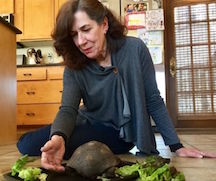 Besides George, Jeanna and her husband have a Labrador Retriever named Reggie. George has had many other dogs, all Labradors, with Reggie being his fifth. Of course George outlives all of them. George gets along with his dogs, but you still have to watch when they are together, because certainly a puppy would be over curious and might feel that George is chew toy. As a result she never leaves a dog along with George.
Besides George, Jeanna and her husband have a Labrador Retriever named Reggie. George has had many other dogs, all Labradors, with Reggie being his fifth. Of course George outlives all of them. George gets along with his dogs, but you still have to watch when they are together, because certainly a puppy would be over curious and might feel that George is chew toy. As a result she never leaves a dog along with George.
Jeanna explains that while it is not legal to own a desert tortoise in Minnesota, it is also not illegal for her in the sense that George was born in captivity and gifted to her many, many years ago. Now, you can't acquire these tortoises anymore because they are on the endangered species list.
So how does a desert tortoise survive in Minnesota? Jeanna explains that George only summers outside and spends the rest of the winter months inside the house. In his natural habitat, George could live 40 to 60 years. However, in captivity he may push 80 or 100. While Jeanna did think about his longevity as a little girl, it never occurred to her that he wouldn't be around. So chances are that George could easily live to 100, especially being protected inside, and can outlive Jeanna and her husband. Jeanna has thought of this and has a daughter who lives a mile from them. That daughter has four children and they all love George. Eventually George will go and live with another family member.
Who Doesn't Like Dogs? - Dr. Debbie
 I love dogs, and always have. But what happens when you discover a close friend doesn't merely not like dogs, but actually hates them?
I love dogs, and always have. But what happens when you discover a close friend doesn't merely not like dogs, but actually hates them?
I've been operating under the assumption that those who don't like dogs must have some evil lurking in their spirit and were destined to a life of incarceration. Just look at the statistics of criminals that abuse animals early on and who later progress to physical abuse of people, murder, or other sociopathic behaviors.
I'll admit not liking dogs is a far cry from turning one's hand to injure an animal or person, but some uncomfortable association is still there. As a full-fledged dog lover, or enthusiast of any animal for that matter, I cannot understand the psyche of an individual that is satisfied going about their life without animal companionship.
Any pet lover can spout off a list of benefits their furry one brings to their life…the steady comfort of companionship, a non-judging ear to hear out the day's tribulations, a workout or hiking buddy and a source of unconditional love at the end of a long day.
So, imagine my shock when I realized that a couple I know doesn't like dogs. Not just that they don't have dogs or misunderstand them - they actually dislike dogs.
Hint of this fact should have been apparent a long ago when they were over for dinner and they politely stood stiff as Calvary front line, when greeted by my yapping terrier mix. Or that they failed to stroke my Labrador's chin after receiving the gentle nudge of the typical canine greeting upon entering the home. The polite perfunctory smiles went un-noticed by me. "Sure, they don't have dogs," I reasoned as to why they weren't charmed by my little dog's amusing tail wagging display or by the steadfast devotion of my Labrador's greeting.
All of these sign posts I missed. I clearly misjudged all along. The couple, who I just assumed were just not yet fortunate to understand the benefits of pet companionship, were actually formidable dog dislikers.
Realization struck me during a recent conversation with this couple. I was laughingly describing the vast differences in dog breed behavior comparing my former Labradors, to that of my current Bouvier. My comments must have been mistaken as some underhanded means to convince them the right breed was out there for them. At that moment, my guest raised hands and said, "I know what I like and don't like, and I don't want dogs." Clearly they didn't like dogs - and they misunderstood my comment as some means to turn them over to the canine side against their will. Astounded, I marveled how this response was not unlike a person who is recommended a mushroom containing side dish or gourmet meal from a fine restaurant, and who declares "I can't stand mushrooms and don't want anything to do with mushrooms!"
 So why didn't I catch on to these dog haters sooner? For those of us that have pets, of any type, we recognize the many joys our pets bring to our lives. There are folks that don't want to bring that companionship into their life. The cogs of their lives have clicked along just fine without a pet in their life. Somehow lots of well-educated, social and seemingly normal people can raise a family and be successful and still dislike dogs.
So why didn't I catch on to these dog haters sooner? For those of us that have pets, of any type, we recognize the many joys our pets bring to our lives. There are folks that don't want to bring that companionship into their life. The cogs of their lives have clicked along just fine without a pet in their life. Somehow lots of well-educated, social and seemingly normal people can raise a family and be successful and still dislike dogs.
Maybe we should feel sorry for them. Or maybe they feel sorry for us, for all the money, heart and time we put into a pet companion who's lifespan doesn't come near to that of a humans. They probably laugh at our reckless expenditures on a being who lives just a fraction of human life. I chose not to spend time wondering how they have made it without animals in their life…rather that I have succeeded because I have been fortunate to have animals in my life.
I ask that these non-pet people save their pity for me and my pets, because I know that any one of my dogs could say they lived live fuller than most people - full with adventure, splendor at new experiences and embracing the moment. And so have I at their side. So should the question come up at the time of my next life, I'll take both a side of mushrooms…and pets on the side.
Featured veterinarian known as "Dr. Debbie" on national pet radio program, Animal Radio. Ebook author of "Yorkshire Terriers: How to Be Your Dog's Best Friend"; "Pugs: How to Be Your Dog's Best Friend"; "Mini Schnauzers: How to Be Your Dog's Best Friend"; and "Shih Tzu: How to Be Your Dog's Best Friend." Dr. Debbie's books.
Animal Radio News - Lori Brooks
Rules For Flying With Animals
The Transportation Department was seeking comments for drafting rules for dealing with animals flying with passengers on planes. The proposal asked for comments about questions such as: whether to treat psychiatric service animals the same as other service animals, such as for the blind and deaf; how to distinguish emotional-support animals from other service animals; whether to require emotional-support animals to travel in containers or with a harness or leash; potentially limiting the types of animals qualifying as emotional-support animals; and potentially prohibiting airlines from requiring veterinary health forms or immunization records for service animals. Because of the rulemaking, the department says it focused enforcement on clear violations of current rules that affect the largest number of passengers.
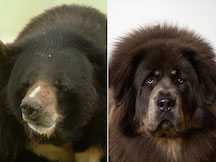 Is it Really Canine Confusion?
Is it Really Canine Confusion?
There is much canine confusion in China. Just a few days after news broke that a woman found out her puppy bought from a Chinese pet store last year was actually a fox, another woman came to a similar conclusion about what she thought was her pet dog. In this case, the woman bought a puppy believing it was a Tibetan Mastiff. From day one, the woman says her family was amazed by their pet's massive appetite as the animals chowed down on a box of fruit and two buckets of noodles every day. However, it wasn't until the pet reached 250 pounds and started walking around on its hind legs that they realized there was a mistake. Their dog was actually an Asiatic black bear that has since been given to a Wildlife Rescue Centre, where it will receive proper care from wildlife professionals. Asiatic black bears are listed as a vulnerable species. They're in high demand in places like Vietnam, where they're illegally traded and milked for their bile. The yellow liquid is falsely marketed as a treatment for everything from cancer to hangovers. The founder and President of Wildlife Rescue & Rehabilitation in San Antonio, says young wild animals have a different look and smell to them compared to domesticated pets. Wild animals will also be more scared and anxious in unfamiliar environments with humans than their domesticated counterparts might be. He says his first reaction to this is that there's something more going on than just an honest mistake. In other words, if a person is tied up in a controversial (possibly criminal) situation with animals, saying they mistook a wild animal for a domesticated one, could be a way out of legal charges.
 Listen to the entire Podcast of this show (#1162)
Listen to the entire Podcast of this show (#1162)





